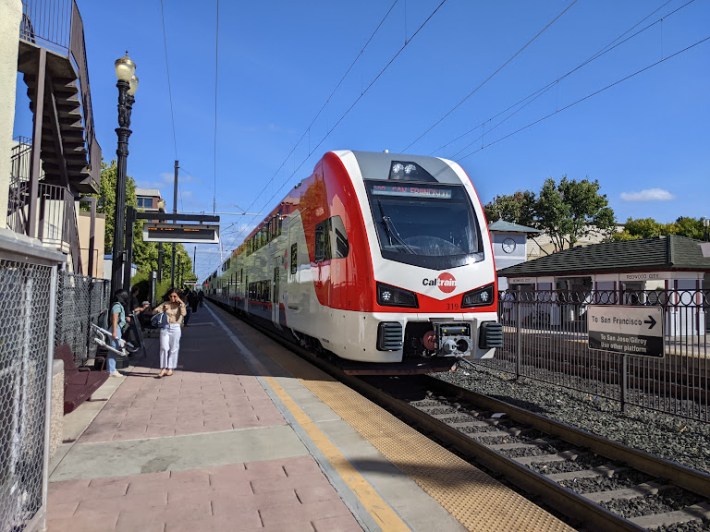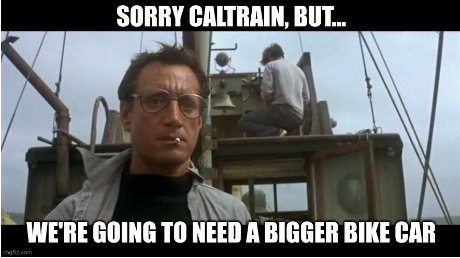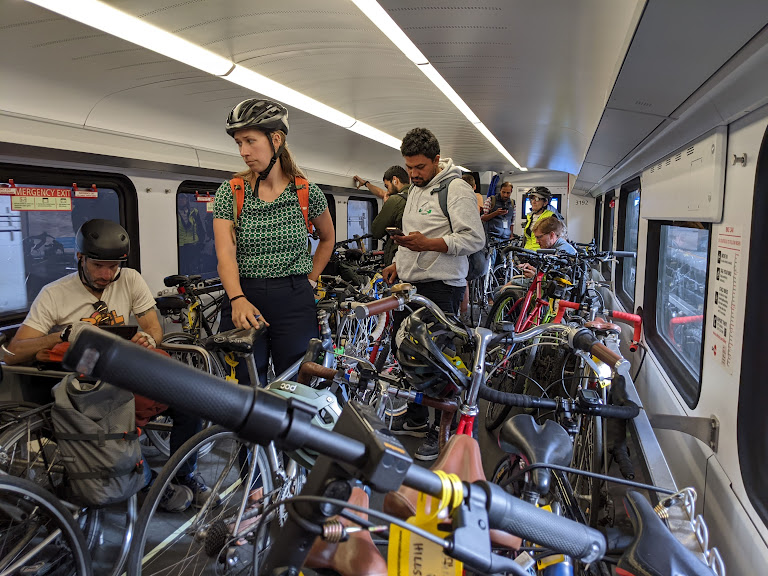Caltrain is now running electric trains up and down the Peninsula carrying passengers (and, frequently, their bikes) in regular service. The new trains are, for now, randomly rolled into the existing diesel schedule. Starting Sept. 21, Caltrain will go 100 percent electric, with new, faster, more frequent schedules that exploit the much greater acceleration and performance of the electric fleet.
But how is this going to work out for commuters who need their bikes to get to and from their final destinations, which are often too far from the stations to walk? Streetsblog took a ride on a rush-hour electric train from Redwood City to San Francisco to check it out. The trains are zippy, quiet, and smooth. But, as seen in the lead image, the bike car was at near-crush load.

"Caltrain commuters like myself know the agony and stress of crush capacity in the bike car during rush hour—this isn't a new phenomenon," wrote the Silicon Valley Bicycle Coalition's Clarrissa Cabansagan in an email to Streetsblog.
Back in pre-COVID 2019, bicycle advocates begged Caltrain to have three bike cars per electric train (instead of two), considering the demand at the time. "Electric trains will have 72 bike spaces per train, whereas today’s diesel trains have 77 bike spaces on average. Caltrain broke its promise made to the public in 2015 for more bike capacity on electric trains," said Shirley Johnson, who helped found the advocacy group BIKES ONBoard, in an interview in 2019, following the Caltrain decision to reduce bike-carry capacity on the new fleet.
"We have been pleased to notice a growing number of riders taking advantage of the bike car, but have only had it reach capacity once since we first introduced electric trains into service," wrote Caltrain spokesperson Dan Lieberman, in an email to Streetsblog. "After the full launch on September 21, we expect the increased frequency of service to help to spread cyclists out over more trains and prevent overcrowding."

Caltrain's weekday ridership is still about a third of what it was in 2019, before the COVID pandemic. Its trains now carry about 23,000 people every weekday, although it's been steadily increasing and should go up more with the coming improvements in train frequency and speed. Still, if ridership is only one-third of what it was, it seems hard to believe the new schedule alone is going to fix the crowding seen in the lead image on a rush-hour electric train. Readers are encouraged to comment on recent experiences with the bike cars, both on the old diesels and the electrics.
Streetsblog will check again after the new schedule goes into place next month. However, Johnson remains convinced it was a mistake to reduce bike capacity. "It is a shame that Caltrain did not listen to its customers during the design phase of the electric cars," she wrote in an email to Streetsblog. "Retrofits are expensive."
Lieberman, meanwhile, points out that Caltrain has installed 300 new bike lockers at its stations, so that, at least in theory, fewer people will need to take their bikes on board in the first place. "Passengers with bikes have been an important part of Caltrain’s ridership for years, leading us to carry more bikes than any other heavy rail system in the country, and we will continue to monitor the bike cars to ensure that everyone gets a safe, comfortable and convenient ride."
"We're working more closely with Caltrain to understand how the needs of bike riders can be adequately addressed through the transition," said Cabansagan. "I am hopeful that we will see less crowding when trains go to fully electric and higher frequency service by September. More bikes on transit is always a good problem. Of course, we'd take an additional bike car any day."






